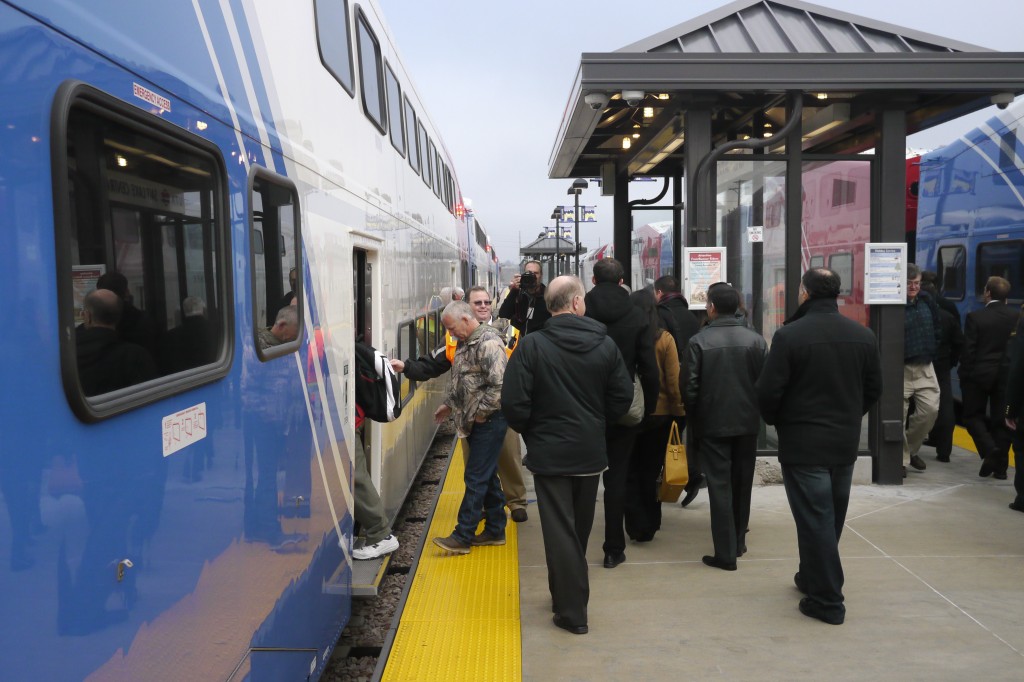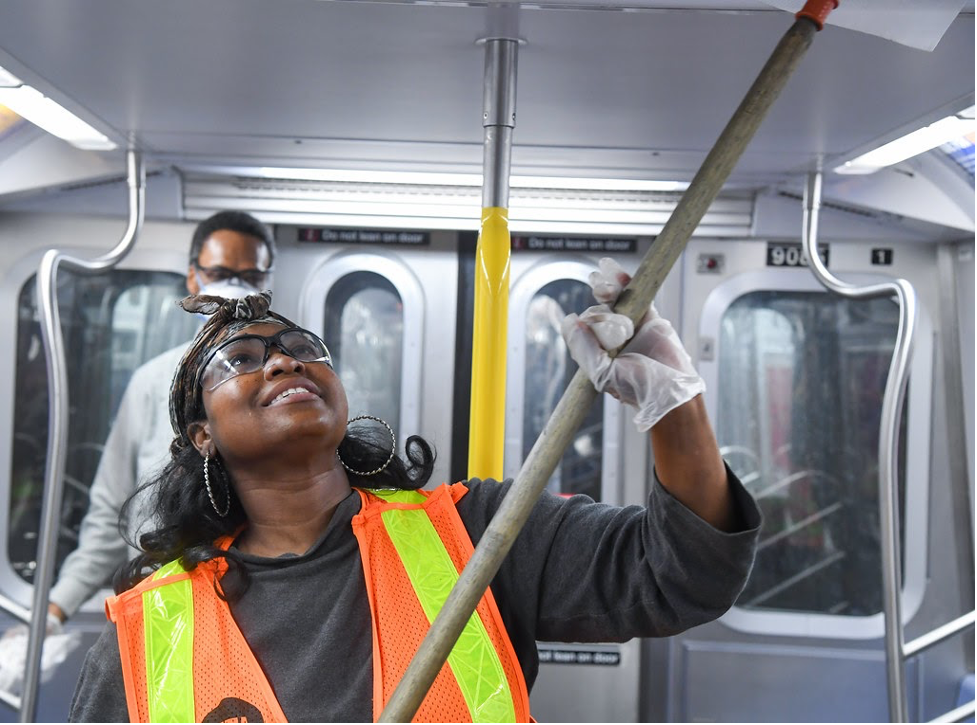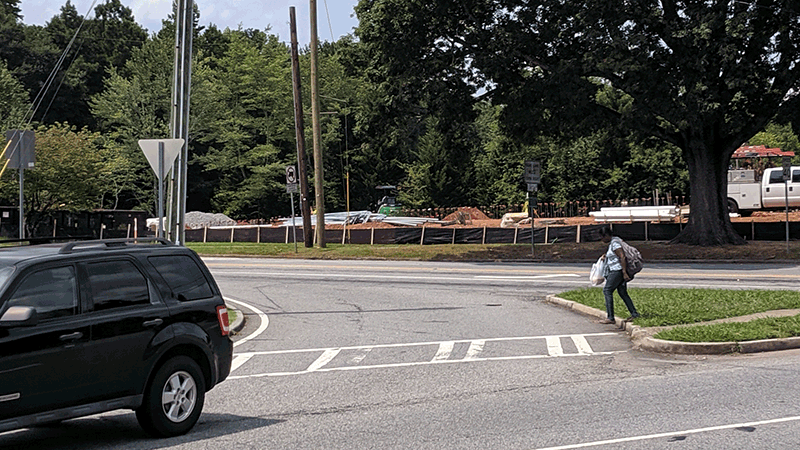
Despite the rhetoric, the infrastructure law falls well short of truly addressing the decades of harm our transportation system has inflicted on marginalized communities, and could even exacerbate existing inequities. However, it does provide some notable opportunities to restore and invest in these communities’ infrastructure needs.

This post is part of T4America’s suite of materials explaining the 2021 $1.2 trillion Infrastructure Investment and Jobs Act (IIJA), which governs all federal transportation policy and funding through 2026. What do you need to know about the new infrastructure law? We know that federal transportation policy can be intimidating and confusing. Our hub for the new law will walk you through it, from the basics all the way to more complex details.
Our transportation system should be designed to connect all people to essential jobs and services through affordable and accessible transportation options. However, our system has largely prioritized access and options for wealthier and whiter communities while creating barriers and dividing Black and brown communities in the process.
Of the $643 billion in the infrastructure law, there are few dedicated programs that directly address equity in our transportation system. However, there are steps in the right direction, including historic funding for transit infrastructure ($109 billion), new programs such as the Reconnecting Communities Pilot Program, and changes to the local match requirements for certain competitive grants for projects in areas of persistent poverty.
The Biden administration and Congress missed an opportunity to create an underlying standard for equity in the infrastructure law. Sure, the administration’s Justice 40 initiative aims to invest federal money equitably, but this is not a permanent solution as it can be easily undone by future administrations. And as we wrote about in our posts on climate, access, or other similar priorities, the freedom and ability to prioritize advancing equity and undoing past harm in communities lies with the states and metro areas who control the lion’s share of the law’s funding. And it’s up to them what they choose to prioritize.
What’s in the law?
First, each of the largest formula grant programs (like the NHPP and STBG) and every other program with broad eligibility can and should be used to promote equity by undoing the damage to marginalized communities. Check out our IIJA hub for guides on how to make sure equity underlies all spending, category by category. But here are some categories worth noting in particular:
The infrastructure law authorizes $109 billion, an increase in federal funding by nearly 80 percent for public transit projects through formula and competitive grant programs. Expanding and improving transit is the best way to serve and improve access to jobs and opportunity for marginalized communities, especially when it’s low-cost and high frequency. For low-income and communities of color who often rely on public transportation the most, making the right investments that improve accessibility and reliability, that connect people to food, health care, educational services and jobs, can have immense financial and quality of life impacts.
The Reconnecting Communities Pilot Program and the Healthy Streets Programs are two new competitive programs that go directly toward undoing past damage or addressing disparities created by our transportation investments in Black and brown communities. However, if states use their formula funds as they historically have, these smaller programs will be overwhelmed by the damage that is still being created by highway projects that just keep hurting these same communities.
The Reconnecting Communities Program was funded at $1 billion over five years for the planning and construction of projects that reconnect communities divided by viaducts, highways, and other principal arterials. For the people who call these communities home, these divisions continue to have catastrophic impacts on health outcomes, safety, and local economies. The restorative projects funded by this new program, which T4America helped create and introduce in Congress in late 2020, will help undo this damage by removing, retrofitting, or replacing an infrastructure barrier to restore community connectivity.
This is a good starting point, but it’s important to note that $1 billion over five years only begins to address the decades of “urban renewal” projects built to divide communities. The cost of dismantling divisive highways rivals, and in some cases even surpasses, the billions of dollars spent over decades to build these highways in the first place. Remember that while the Reconnecting Communities Pilot Program is small compared to the amount of work that needs to be done to restore historically marginalized communities, states have the ability to use their highway formula funds to complete highway teardown projects. They do not need this specialized program in order to do highway removal projects. The limited funds for the new pilot program should not be used as an excuse to continue to ignore these communities that have experienced decades of harm.
The Healthy Streets Program is a competitive grant program authorized at $100 million annually but is subject to congressional discretion for funding year after year. This program was created to fund projects that address the urban heat island effect that has disproportionate negative health impacts on low-income as well as Black and brown communities. In a harbinger of what could happen in future years for these sorts of helpful but small programs that Congress created in the IIJA (which the administration touts as their effort to eliminate inequities), this program did not receive funding from Congress for FY22, while states received all the funding they could possibly need to continue to harm these communities.
In addition to these programs that were designed to directly address inequities within our transportation system, the infrastructure law revised the federal cost share requirements in the existing Local and Regional Project Assistance Program. For most competitive grant programs the federal cost share is capped at 80 percent, which means the eligible applicant(s) must come up with 20 percent of the grant award for the project (also known as the local match). But for the $3 billion per year available in the Local and Regional Project Assistance Program, projects in rural areas, historically disadvantaged communities, or areas of persistent poverty can receive up to 100 percent of the cost of the project from the federal government, requiring no local match.
On the topic of more equitable grant distribution, the infrastructure law also requires certain criteria the Secretary should use when selecting projects for competitive grant awards. The National Infrastructure Project Assistance Program directs the Secretary to consider how a project would benefit a historically disadvantaged community or population or an area of persistent poverty when awarding grants. The Safe Streets and Roads for All Grant Program instructs the Secretary to consider if the applicant ensures equitable investment in the safety needs of underserved communities in preventing transportation-related fatalities and injuries.
The Corridor Identification and Development Program directs the Secretary to outline the process and criteria to facilitate the development of intercity passenger rail corridors. The law directs the Secretary to consider whether the corridor serves historically unserved or underserved and low-income communities or areas of persistent poverty when selecting a corridor for development.
What can the administration do to promote equitable outcomes?
Black and brown communities have suffered from harmful and dangerous transportation projects for far too long, and there are great opportunities beyond those programs with equity as their central purpose for the administration to restore and rejuvenate these communities. One clear way the administration can do that is to use as many competitive grant programs as possible to fund projects that remove barriers, revitalize marginalized communities, and prioritize projects with strong anti-displacement actions in place.
The administration also has a lot of flexibility and leeway in the guidance and models that are used in transportation. Many of these models contribute to worsening conditions and exacerbate the equity issues from our transportation system. The administration should reconsider their models to measure access to jobs and services for drivers and nondrivers alike. The administration should also provide technical assistance to state DOTs, MPOs, and transit agencies on how to measure multimodal access to jobs, essential services, fresh food access, and public health.
In addition, USDOT should also replace the value of time guidance, which primarily focuses on the impact that transportation decisions will have on the limited number of people who are driving, ignoring the impacts on all other travel. Read our recommendations for the administration in this post about value of time and how it can be improved.
Another way the administration can improve equitable outcomes is to define “reasonable cost” and how it applies objectively and equitably across the federal transportation program. Reasonable cost is used to estimate an infrastructure project’s cost that includes construction, engineering, acquisition of right-of-way and other related costs. What often happens is that when a project is deemed “too expensive” and the project includes bike and pedestrian elements, decision makers will use “reasonable cost” as an excuse to ignore or remove these elements from a proposal. Reasonable cost gives heavy preference to the infrastructure needs of cars, when it should instead better include and prioritize other road users and nondrivers, who are disproportionately people of color.
How can the new money advance other goals?
Climate
The built environment exacerbates the negative impacts of climate change on low-income and communities of color. Marginalized communities have suffered from higher air pollution levels, energy costs, and heat-related health effects as a result of urban heat islands. Investing in infrastructure that protects our most vulnerable communities from the impacts of climate change will have positive impacts for these communities and our environment. We wrote about how the infrastructure bill can be used to lower emissions and address resiliency here.
So what?
There was a missed opportunity to embed equity into the fabric of the infrastructure law, so it is now up to USDOT to use all of their tools to ensure equitable outcomes for our most vulnerable communities. States also have an opportunity now to reevaluate and change the way they spend their formula dollars. Congress and the administration will have utterly failed if this historically huge infusion of infrastructure funding just results in more projects that place excessive burdens on the same historically marginalized communities. Expanding highways to serve more affluent communities who can afford to own a car cannot continue as the status quo.
We must center the desires and lived experiences of the communities we are restoring to reverse the transportation planning trends that continue to lead to injustices. This means improved outreach to these communities to understand the problem inclusively, especially through the lens and perspective of marginalized communities that are most negatively affected by our infrastructure investments.
The flexibility in the formula programs allow for states, cities, and MPOs to conduct community outreach and public engagement in the planning process for projects. These entities should be using these funds to conduct robust public engagement to ensure any transportation project meets the needs of marginalized communities. That will mean truly engaging the community to define the problem, taking full stock of the tools in the practitioners’ toolbox to address the problem, and looking at strategies to integrate community feedback into how those tools are used. From tabletop exercises to outright pilot projects that allow communities to touch and feel potential solutions, there are plenty of opportunities to create community buy-in and ownership of transformative transportation solutions, rather than impose transportation investments on the communities who need their voices heard most.







